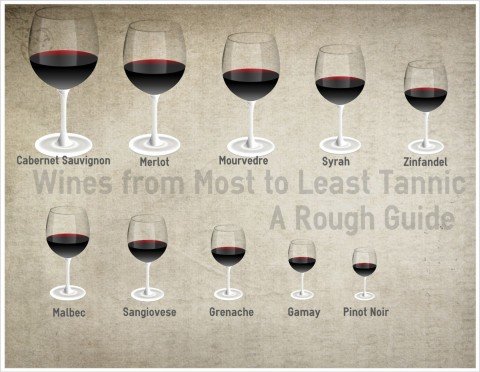Hello, and welcome back to the Sommelier Selection! Let’s get started on a topic I’ve been looking forward to delving into for a while now. To refresh, one of the primary goals of this ongoing blog is to demystify the buying and ordering process of wines you’re unfamiliar with. And, this discussion is of monumental importance to achieving that aim. Now, if I polled my reader base with the following question: How many of you find yourself telling waiters and wine stewards alike that you prefer wines that aren’t “bitter” or “acidic”?, I’m sure the vast majority of you would raise your hands. Whereas, the truth of the matter is, ALL of you love wines that can be (at times) identified with those very same descriptors. I know, you think I’m crazy, but stay with me. The true scope of this blog entry will encompass broad definitions of Acid (which is mouth-watering) versus Tannin (which is mouth-drying), and what that all means to the wine consumer. But, that made for a very boring title. However, knowing the key differences between these very important components found in every bottle of wine you open will keep you from not only confusing the wine staff at your favorite local restaurants, but also to help you in your successful exploration of new wines without having the fear of wasting your hard earned money on something that might not fit into your preferred taste profile. First, let’s define what each one is.
Acidity
When found in food and drink, it’s experienced as tart and zesty. Tasting acidity is often confused with the taste of higher alcohol. It is common for wines grown in cooler vintages (or, years) to have higher levels of acidity. That’s because sugar and acid generally have an inverse relationship. With warmer vintages (and climates), we get riper grapes. Riper grapes yield higher levels sugar [and sweetness]. Higher levels of sugar are met with lower levels of acid. Wines with higher levels of acidity feel lighter in weight. If you prefer a wine that is more rich and round, you enjoy slightly less acidity.
Characteristics:
- Mouth-watering, which is focused on the front and sides of your tongue.
- If you rub your tongue to the roof of your mouth it feels gravelly.
- Your mouth feels wet, the same sensation as when you bite into an apple or pear.
Tannin
Tannin is often confused with dryness, because tannin does just that. It dries your mouth. Tannin in wine is the presence of phenolic compounds that add a bitter quality. Phenolics are found in the skins and seeds of grapes and can also be added to a wine with the use of aging in oak. So, how does tannin taste? Imagine putting a used black tea bag on your tongue. A wet tea bag is practically pure tannin. It’s bitter, has a drying sensation, and it tastes herbaceous. While all of these descriptors sound very negative, tannin adds structure, complexity, and balance.
Characteristics:
- Tastes bitter at the front of your mouth and along the side of your tongue.
- Tannin makes your tongue dry out.
- After you swallow you taste a lingering bitter/dry feeling.
 Am I tasting acid or tannin?
Am I tasting acid or tannin?
You’re probably tasting both, as they’re both found in all wines. To distinguish between the two, I like to think of acid as a squirt of lemon or grapefruit – it adds a juicy brightness that balances sweetness or richness. Tannins are more about grip. Literally, they hold on to the sides of your mouth. They give a wine traction. If they’re smooth, they can be described as velvety. If not, they can be described as harsh and drying.
What do each actually do?
Most importantly, and aside from how they affect our taste buds, is the function of facilitating aging. Wines with higher amounts of natural occurring tannin (like Cabernet, Merlot, and Nebbiolo), age beautifully. Tannin acts as a natural preservative of wine, and as it breaks down over time it adds to the complexity of how a wine tastes. But then, there are red wines that age gorgeously which have very little natural tannin. How is that possible? If I put you on task to go read the back of any candy wrapper for the ingredients, you’d likely find listed a combination of many acids. This is why a candy bar can sit on the shelf for weeks on end and not spoil. So, wines like Pinot Noir and Syrah, which have lower levels of tannin, but greater natural occurring acidity, benefit tremendously from the preserving function acid provides. And, you guessed it; wines with low levels of both tannin and acid won’t age well at all. They’re meant to be opened right now, like the famous tables wines enjoyed daily at lunchtime across all of Italy.
The actual lesson…
I applaud you for making it this far. Now that you know the basic characteristics and have an understanding of what tannin and acid are, where do you go from here? Well, wherever you want – but now you have a map and a compass. Think about it. When might you grab that mouth–watering bottle of Chardonnay from Chablis? I’m thinking when you’re throwing back 2 dozen oysters with your best mates in Malibu with sea salt and sand in the air. Or, when would you need a big, robust, and tannic Cabernet from the Napa Valley? Probably to cut through the fat of those rib-eye steaks you’re grilling up at this summer’s backyard BBQ. Here’s a good cheat sheet:
Red Wines with Higher Tannins
Pairs well with beef, pork, venison, lamb and strong cheeses
Cabernet, Merlot, Malbec, Cabernet Franc, Brunello, Barolo
Red Wines with Higher Acid (and lower tannins)
Pairs well with salmon, veal, rabbit, and various stews
Pinot Noir, Syrah, Grenache, Gamay, Sangiovese
White Wines with Higher Acid (White wine doesn’t have tannin)
Pairs well with oysters, salads with citrus based dressings
Chardonnay, Sauvignon Blanc, Champagne
White Wines with Lower Acid
Pairs well with raw shellfish, chicken, white fish
Pinot Grigio, Alberiño, Grenache Blanc, Marsanne, Rousanne, Viognier
Also, it’s a good general rule that wines from Europe will have higher acid levels then those of the US and Australia because of the ripeness explanation I made above. So, if you’re like me and you like tooth-enamel-stripping acid, set your sites on wines from Northern Burgundy, Alsace, Austria, and Germany.
Lastly, when you’re feeling like you want to try something other than your standard go-to wine of choice, pick one from the same category I listed above. If you live and die for Cabernet, chances are you’ll like a Malbec or Cabernet Franc. If you like like Pinot Grigio, you’ll undoubtably love Alberiño.
Per usual, I hope that helps on your quest to gain a clearer understanding of wine. It’s a lot to take on, but I can promise you, if you stay committed to experiencing wine with even the slightest of scrutiny, you’ll enjoy it exponentially more.
For now, cheers from the Sommelier Selection.
And, don’t forget to follow me on Facebook and on Instagram for all the latest pockets and Pinots.


